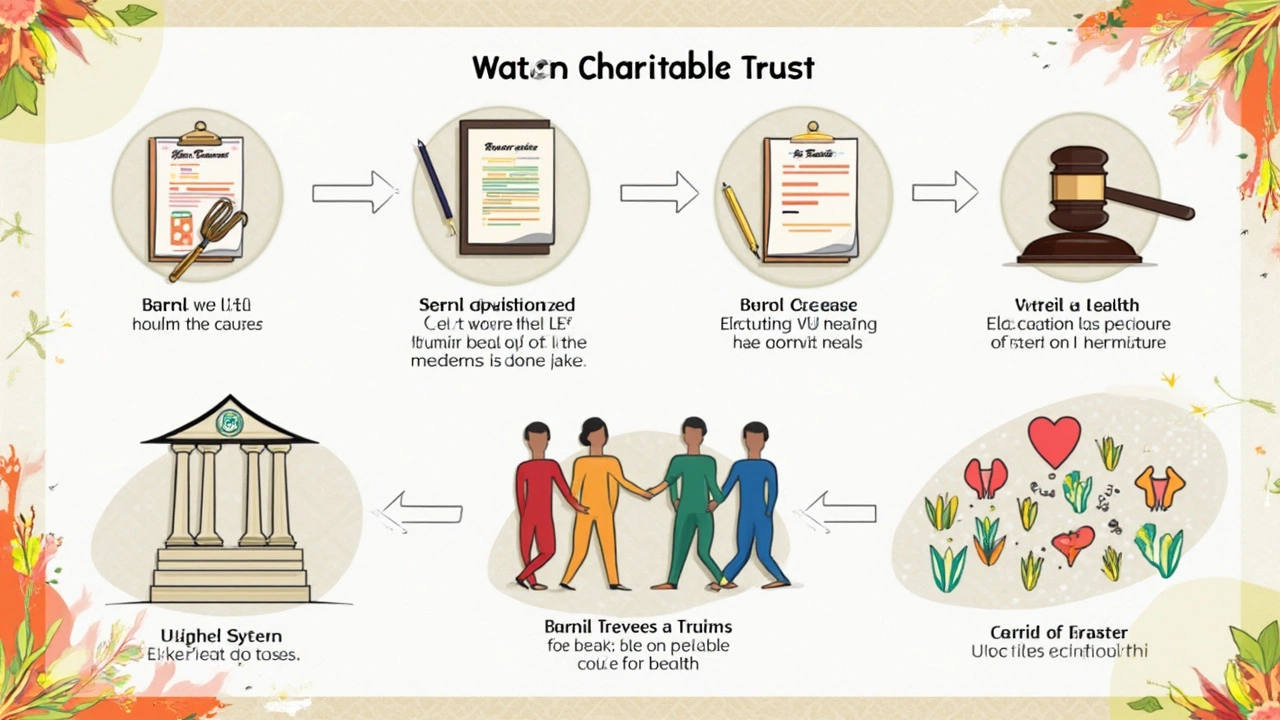Charitable Trust Structure: How It Works and Why It Matters
 May, 17 2025
May, 17 2025
A charitable trust isn't just a nice idea—it's a legal setup that lets you put money or assets aside to help causes you care about. There's a reason it works so well: the structure keeps everything organized and makes sure the money goes where it's supposed to. But it's more than just handing over a check to your favorite charity.
Why does the structure matter? It makes sure no one runs off with the funds and that everything lines up with the law. If you've ever wondered who makes decisions, who benefits, and how to keep it all above board, you’re in the right place. Getting the structure right from day one saves tons of headaches down the road.
- What Is a Charitable Trust, Really?
- Key Parts: Who and What Makes Up the Trust
- Roles of Trustees and Beneficiaries
- Legal Steps and Compliance
- Tips for Managing Your Charitable Trust
What Is a Charitable Trust, Really?
A charitable trust is a legal setup where you hand over money or property to be used for good causes. It’s not the same as giving a simple donation—this is a structure built to manage and protect your gift so it keeps supporting something bigger than yourself, often for years or even generations to come.
Typically, the process starts when someone (the person setting up the trust, called the settlor or grantor) hands over assets to a group of people or an organization (the trustees). The job of the trustees is to make sure that these assets are used in line with the specific charitable purpose you pick out from the start—like education, poverty relief, medical research, or things like public parks and cultural projects. The purpose has to line up with what’s considered “charitable” under the law, which usually means something that benefits the public in a meaningful way.
Here’s what separates a charitable trust from other setups: it’s all about public good, not personal profit. Unlike a family trust—which is just for your relatives—or a business trust, the rules for a charitable trust are much tighter. You get some major tax perks if everything’s done right, but that means playing by the rules at every step. The assets aren’t yours anymore once you set the trust up, and the trustees have to follow the purpose exactly as written down—no switching it later unless a court gets involved.
Some folks use charitable trusts to support a favorite cause after they’re gone, while others use them right now for tax reasons or just to make sure their money is well spent. Either way, you’re not just giving money—you’re creating a system to keep giving for the long haul.
Key Parts: Who and What Makes Up the Trust
A charitable trust is built around a few main parts. You need all of them, or the whole thing just doesn’t work. At the core, there are three key players plus the important stuff the trust actually owns.
- Charitable trust: This is the legal setup itself, holding assets for specific charitable purposes.
- Settlor (sometimes called a grantor): This is the person who sets things up and puts money or assets into the trust.
- Trustees: These folks run the show day-to-day. They’re responsible for handling the trust's money or property, making sure everything is above board, and following the rules the settlor laid out.
- Beneficiaries: With a regular trust, beneficiaries are usually family. Here, the beneficiaries are one or more charities, or sometimes a whole group of causes.
- Trust Property: This means the money, stocks, real estate, or whatever gets put into the trust for charitable use.
Every charitable trust structure needs a written document called a trust deed. Without it, nothing’s official. That deed spells out who the trustees are, their powers, who the beneficiaries will be, and which charity/cause gets the funds. Usually, the trust deed also describes exactly what kind of grantees are allowed and what purposes the trust can support.
Here’s a quick breakdown of the main parts and who does what:
| Role | Main Job | Common Mistakes |
|---|---|---|
| Settlor | Creates and funds the trust | Forgets to set clear charitable goals |
| Trustees | Manage and distribute trust assets | Poor record-keeping or conflicts of interest |
| Beneficiaries (Charities) | Receive grants/support from the trust | Not keeping up with compliance checks |
| Trust Property | Assets held for charitable use | Lack of diversification or undervaluation |
Interesting fact—according to the UK's Charity Commission, over 95% of registered charitable trusts are set up for specific purposes, like education or medical research. That just shows how common it is to get specific with your mission.
One pro tip: picking the right trustees matters more than most people think. They don’t just sign papers—they make the big calls and have to stick to the trust’s purposes. Lots of headaches get avoided if you choose people who are responsible and know their stuff.

Roles of Trustees and Beneficiaries
Every charitable trust stands on two key groups: trustees and beneficiaries. Get these right, and the whole thing runs smoothly. Mess them up, and you’re in for trouble.
Trustees are the folks in charge. They’re like the managers of the trust—they hold the assets, make decisions, and must always act in the best interest of the cause. You can have just one trustee, but often there are a few, especially when serious money is involved. Here are their main jobs:
- Managing the trust’s assets (money, property, stocks—you name it)
- Making sure funds are used for the specific charitable goal
- Keeping accurate records of every decision and transaction
- Filing annual reports to the authorities
- Following all local laws and trust guidelines
Most states demand at least one trustee to be independent, especially for tax perks. In fact, the IRS checks if the trustee isn’t related to the person who set up the trust. If you’re thinking about being a trustee, expect the hours to add up fast—annual reports, meetings, and audits can eat into your weekends.
Now, who actually gets the trust’s help? That’s the beneficiary. With a charitable trust, your beneficiaries aren't just a single person; they're a group or cause. For example, a trust might pay for kids’ meals in a local district, or fund scholarships for first-generation college students. It all depends on the trust’s chosen mission. Charitable trust law won’t let you pick your cousin Nancy or your best friend as the sole beneficiary—there has to be a public or charitable purpose.
Check out some quick facts about trustees and beneficiaries in trusts:
| Role | Main Responsibilities | Who Can It Be? |
|---|---|---|
| Trustee | Manage assets, follow the law, file reports | Individual or organization (sometimes a bank or law firm) |
| Beneficiary | Receive support (funds, services, etc.) | Charities, public groups, or specific causes |
If you’re ever picked as a trustee or named as a beneficiary, make sure you’re crystal clear on what that means. Trustees can be held legally responsible if anything goes sideways. For beneficiaries, clarity about what you’ll actually get (and when) makes life a lot easier. When in doubt, get professional advice—mistakes in this area can get costly fast.
Legal Steps and Compliance
Setting up a charitable trust gets pretty official—you don’t just scribble something on a napkin and call it good. Legal steps make sure your trust survives audits and does real good. Here’s what you really have to do:
- Draft the Trust Deed: This is your playbook. It lays out the purpose of the trust, who’s managing it, and who benefits. Don't skip naming an exact purpose—being vague can get your trust in trouble right out of the gate.
- Appoint Trustees: You need people (or organizations) you trust to make decisions. In most places, two trustees are the bare minimum, and you can’t make yourself the only one if you want charity status.
- Register the Trust: This isn’t optional. In the U.S., register it with your state’s Attorney General or Secretary of State. In the UK, you’d go through the Charity Commission. Paperwork requirements change depending on where you live, so double-check the details before you start.
- Get a Tax ID: If you’re in the U.S., you’ll need an Employer Identification Number (EIN) even if you don’t have employees; it’s basically an ID card for your trust. This step triggers eligibility for tax benefits, like the ability to accept tax-deductible donations.
- Apply for Tax-Exempt Status: In the U.S., file IRS Form 1023 or 1023-EZ to have your trust recognized as a 501(c)(3) charity. Without that, donors can’t write off their gifts and your trust might owe taxes—big yikes.
Follow-up doesn’t end when the paperwork is done. Keeping a charitable trust legit means staying up to date with reports, renewals, and keeping records tidy. Here’s what’s on the ongoing to-do list:
- File annual reports with the IRS (Form 990), your state, or the Charity Commission if you’re in the UK.
- Keep detailed records of all incoming donations, grants, outgoing payments, and decisions made by trustees.
- Hold regular trustee meetings and take minutes—yes, even if it’s boring. Regulators expect these details if something gets challenged.
Skipping any part isn’t worth it. In 2023, the IRS revoked tax-exempt status for over 28,000 nonprofit organizations because they didn’t file annual returns. That’s money and reputation gone, just like that.
| Step | Key Document | Where to File |
|---|---|---|
| Register Trust | Trust Deed | State/Local Registration Office |
| Get Tax ID | SS-4 Form | Internal Revenue Service (IRS) |
| Apply for Tax-Exempt Status | 1023 or 1023-EZ | IRS |
One last tip: Grab a good advisor or lawyer if you’re unsure about a step. Mistakes can snowball fast. Paying attention now means your trust can focus on helping others, not putting out legal fires.

Tips for Managing Your Charitable Trust
Keeping a charitable trust running smoothly isn’t just about good intentions. It’s about paying attention to details, staying organized, and following the rules. Here are some tried-and-true tips to help you keep things on track:
- Stay on top of records: Keep every receipt, bank statement, grant letter, and asset list. This makes yearly reporting way easier and keeps you ready for audits. According to a 2023 Fidelity Charitable study, trusts that kept digital records processed end-of-year tax filings twice as fast as those using paper files.
- Run regular trustee meetings: Don’t get lazy—hold at least two trustee meetings each year. Document all decisions, even small ones, in meeting minutes. If you ever face questions from the IRS or state, you’ll have proof you’re following proper procedures.
- Review your beneficiaries: Situations change. Maybe a charity shuts down or new needs crop up. Check annually to make sure your trust’s beneficiaries are still valid and in line with your original mission.
- Know your tax deadlines and laws: Charitable trusts must file Form 1041 with the IRS, and different types have strict distribution rules. Missing a deadline or rule can lead to big fines.
- Invest wisely: Charitable trusts can invest, but there’s a responsibility to avoid risky or self-serving deals. Build a simple investment strategy—keeping most assets in low-cost index funds works for a lot of small and mid-sized trusts.
Look at how most charitable trusts break down their annual administrative effort:
| Task | Average Time Spent Per Year |
|---|---|
| Record-Keeping & Admin | 30 hours |
| Meetings & Minutes | 10 hours |
| Beneficiary Reviews | 8 hours |
| Legal/Tax Compliance | 12 hours |
| Investment Oversight | 10 hours |
Add it up and you’re looking at about 70 hours a year, or less than two hours a week. Not so overwhelming if you stay organized.
Don’t try to do everything yourself. Bring in a CPA or a lawyer familiar with trusts if you get stuck or just want peace of mind. The little cost upfront can save a fortune (and a lot of stress) if you ever run into problems later.